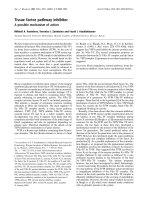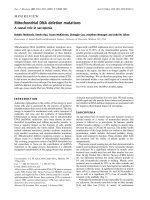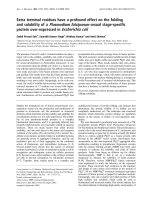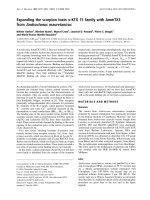Báo cáo y học: "Post heat shock tolerance: a neuroimmunological anti-inflammatory phenomeno" ppsx
Bạn đang xem bản rút gọn của tài liệu. Xem và tải ngay bản đầy đủ của tài liệu tại đây (253.12 KB, 4 trang )
BioMed Central
Page 1 of 4
(page number not for citation purposes)
Journal of Inflammation
Open Access
Hypothesis
Post heat shock tolerance: a neuroimmunological
anti-inflammatory phenomenon
Shahram Shahabi*
1
, Zuhair M Hassan
2
and Nima Hosseini Jazani
1
Address:
1
Department of Microbiology, Immunology and Genetics, Faculty of Medicine, Urmia University of Medical Sciences, Urmia, Iran and
2
Department of Immunology, School of Medical Sciences, Tarbiat Modarres University, Tehran, Iran
Email: Shahram Shahabi* - ; Zuhair M Hassan - ;
Nima Hosseini Jazani -
* Corresponding author
Abstract
We previously showed that the progression of burn-induced injury was inhibited by exposing the
peripheral area of injured skin to sublethal hyperthermia following the burn. We called this
phenomenon post-heat shock tolerance. Here we suggest a mechanism for this phenomenon.
Exposure of the peripheral primary hyperalgesic/allodynic area of burned skin to local hyperthermia
(45°C, 30 seconds), which is a non-painful stimulus for normal skin, results in a painful sensation
transmitted by nociceptors. This hyperthermia is too mild to induce any tissue injury, but it does
result in pain due to burn-induced hyperalgesia/allodynia. This mild painful stimulus can result in the
induction of descending anti-nociceptive mechanisms, especially in the adjacent burned area. Some
of these inhibitory mechanisms, such as alterations of sympathetic outflow and the production of
endogenous opioids, can modify peripheral tissue inflammation. This decrease in burn-induced
inflammation can diminish the progression of burn injury.
Introduction
We previously showed that it was possible to inhibit the
progression of burn-induced skin injury by exposing the
peripheral area of injured skin to sublethal hyperthermia
following the burn [1]. In that study, second-degree burn
injury was induced in mice, some of which had been
injected with the opioid receptor blocker Naloxone 30
minutes prior to burn, and some of which were subjected
to mild local hyperthermia (45°C, 1 and 3 minutes after
burn). After 24 hours, local post-burn hyperthermia had
decreased inducible nitric oxide synthase (iNOS) expres-
sion and tissue injury as assessed by the number of hair
follicles. This effect appeared to be produced by endog-
enous opioid response [1].
Since burns occur due to lethal hyperthermia (lethal heat
shock), and post-burn local hyperthermia (a slight and
non lethal hyperthermia) helps to eliminate burn-
induced injury, the reduction in injury due to post-burn
local hyperthermia can be considered a kind of heat shock
tolerance. Because this tolerance takes place after the heat
shock (burn), the term "post-heat shock tolerance" seems
appropriate [1]. Here we suggest a mechanism that
explains how post-heat shock tolerance might inhibit the
progression of burn injury.
Hypothesis
Tissue necrosis progresses following a burn and is not lim-
ited to the time that the burn occurs [1-3]. The inflamma-
tory response to this stress is one mechanism that can
cause the progression of burn injury. By decreasing the
inflammatory reaction following a burn, we might
inhibit, at least partially, the progression of burn injury
[3].
Published: 27 March 2009
Journal of Inflammation 2009, 6:7 doi:10.1186/1476-9255-6-7
Received: 22 December 2008
Accepted: 27 March 2009
This article is available from: />© 2009 Shahabi et al; licensee BioMed Central Ltd.
This is an Open Access article distributed under the terms of the Creative Commons Attribution License ( />),
which permits unrestricted use, distribution, and reproduction in any medium, provided the original work is properly cited.
Journal of Inflammation 2009, 6:7 />Page 2 of 4
(page number not for citation purposes)
Neurogenic inflammatory responses contribute to burn-
induced inflammation [4,5]. Noxious thermal stimuli to
primary C-afferents lead to the release of various vasoac-
tive sensory neuropeptides, (e.g., substance P), thereby
contributing to local inflammatory events [4].
Burns are followed by the development of an area of
hyperalgesia (and/or allodynia) around the lesion, which
is known as the area of "primary hyperalgesia/allodynia".
Surrounding this area, a zone of "secondary hyperalgesia/
allodynia" appears in the undamaged skin and gradually
increases in diameter with time. Hyperalgesia indicates a
greater sensitivity to pain caused by a reduction in the
pain threshold and an increase in the intensity of
responses to supraliminal noxious stimuli; allodynia, on
the other hand, is a painful sensation induced by nor-
mally non-painful, supraliminal noxious stimuli [6]. In
the zone of primary hyperalgesia/allodynia, the stimulus/
response function due to a thermal and/or mechanical
stimulus is increased. In the area of secondary hyperalge-
sia/allodynia, there is hyperalgesia and/or allodynia only
for mechanical stimuli, and not for heat [7].
The sensitization of the peripheral nociceptors is thought
to be the neurophysiological mechanism underlying the
hyperalgesia and allodynia to thermal stimuli that occurs
at the lesion site. This phenomenon of sensitization to
thermal stimuli has been observed not only in the periph-
eral afferents, but also at spinal, thalamic and cortical lev-
els. These observations, however, might not imply an
autonomous central process of sensitization, but might be
effects of a potentiated peripheral input due to the sensi-
tization of nociceptors [6].
Most nociceptive spinal cord neurons are inhibited toni-
cally by descending inhibitory systems, which maintain
control over the spinal cord. These neurons also are inhib-
ited by heterotopic noxious stimuli, in line with the con-
cept of diffuse noxious inhibitory control. This implies
that painful stimulation at one site of the body might
reduce pain at another site [8]. In fact, it has been
observed that exposure of a defined tissue region to nox-
ious stimuli engages a supraspinal loop, resulting in "het-
erotopic" activation of descending inhibition in other
tissue regions (e.g., surrounding tissue) [9]. Various mech-
anisms are implicated for descending pain control includ-
ing hard-wiring modes of communication and diffusion
of neurotransmitters to sites distant from synaptic cleft. As
it has been reviewed by Millan [9] among the mechanisms
of descending pain control, alteration of sympathetic out-
flow and production of endogenous opioids can modify
peripheral tissue inflammation and its associated nocice-
ption [9-13]. Sympathetic preganglionic nuclei of the tho-
racolumbar spinal cord receive an intense innervation
from several classes of descending pathway, especially,
those containing serotonin or norepinephrin, together
with co-localised neuropeptides (e.g., substance P and
thyrotropin releasing hormone) [9]. Opioidergic and
noradrenergic systems have significant interactions on
multiple levels [14]. At the peripheral level, the finding
that the antihyperalgesic action of an alpha-2-adrenocep-
tor agonist was attenuated by a small dose of an opioid
receptor antagonist injected into the inflamed paw sug-
gests involvement of an opioidergic link in peripheral
alpha-2-adrenergic actions [14,15]. Immune cells that
release opioids in response to norepinephrine provide
one potential link for an anti-hyperalgesic and anti-
inflammatory interaction of opioid and noradrenergic
mechanisms in the periphery [14]. Opioids can inhibit
inflammation by stimulating opioid receptors on
immune cells [16] and decreasing neurogenic inflamma-
tion by inhibiting the release of local pro-inflammatory
neuropeptides (e.g., substance P) from nerve fibers [17-
19].
Since there is hyperalgesia/allodynia in the peripheral
zone of burn injury, it is likely that exposure of this area
to local hyperthermia (45°C, 30 seconds), a non-painful
stimulus for normal skin, results in a painful sensation
transmitted by nociceptors (Figure 1). The cells of area
exposed to hyperthermia should be so mildly injured that
hyperthermia does not produce further sustained injury.
On the other hands, as mentioned above, in the area of
secondary hyperalgesia/allodynia, there is hyperalgesia
and/or allodynia only for mechanical stimuli, and not for
heat [7]. Therefore "peripheral zone of burn injury" refers
to the margins of the area of primary hyperalgesia/allody-
nia.
In normal skin, heat resulting in painful sensation by
nociceptors, carries a risk of tissue damage [6]; however,
the hyperthermia used in post-heat shock tolerance is too
mild to induce any tissue injury, but causes pain in the
presence of burn-induced hyperalgesia/allodynia. This
mild painful stimulus can result in the induction of
descending anti-nociceptive mechanisms, especially in
the adjacent burned area. As mentioned above, some of
these inhibitory mechanisms (e.g., alterations of sympa-
thetic outflow and production of endogenous opioids)
can modify peripheral tissue inflammation [9]. Decreas-
ing burn-induced inflammation can diminish the pro-
gression of burn injury (Figure 1).
How can this hypothesis be tested?
Our previous findings support several aspects of this
hypothesis:
1 – Post-heat shock tolerance decreased the expres-
sion of iNOS [1]. There is some evidence to suggest
that NO might contribute to the development of
Journal of Inflammation 2009, 6:7 />Page 3 of 4
(page number not for citation purposes)
the inflammatory response and secondary tissue
injury following burns [3,20,21]. This is in agree-
ment with the idea that inhibiting inflammation
plays an important role in the mechanism of post-
heat shock tolerance.
2 – When opioid receptors were blocked, post-heat
shock tolerance did not decrease tissue damage
[1]. This is in agreement with the idea that activa-
tion of the opioid system might underlie the
decreased progression of burn injury in response
to post-burn local hyperthermia.
Other parts of the hypothesis, however, still need to be
tested. The following experiments could address key
questions:
1 – If post-burn local hyperthermia activates
descending pain control mechanisms, it should
reduce the pain of burn injury. This could be tested
by evaluating the anti-nociceptive effects of apply-
ing of post-burn local hyperthermia in some vol-
unteers.
2 – If activation of the noradrenergic system is a
mechanism by which post-burn local hyperther-
mia decreases the progression of burn injury,
administration of adrenergic receptor antagonists
before the application of post-burn local hyper-
thermia should inhibit the effects of post-burn
local hyperthermia on the progression of burn
injury.
Competing interests
The authors declare that they have no competing interests.
Authors' contributions
All authors read and approved the final manuscript.
The proposed mechanism for the protective effects of post-burn local hyperthermia against progression of burn-induced injuryFigure 1
The proposed mechanism for the protective effects of post-burn local hyperthermia against progression of
burn-induced injury.
Publish with Bio Med Central and every
scientist can read your work free of charge
"BioMed Central will be the most significant development for
disseminating the results of biomedical research in our lifetime."
Sir Paul Nurse, Cancer Research UK
Your research papers will be:
available free of charge to the entire biomedical community
peer reviewed and published immediately upon acceptance
cited in PubMed and archived on PubMed Central
yours — you keep the copyright
Submit your manuscript here:
/>BioMedcentral
Journal of Inflammation 2009, 6:7 />Page 4 of 4
(page number not for citation purposes)
References
1. Shahabi S, Hashemi M, Hassan ZM, Javan M, Bathaie SZ, Toraihi T,
Zakeri Z, Ilkhanizadeh B, Jazani NH: The effect of post-burn local
hyperthermia on the reducing burn injury: the possible role
of opioids. Int J Hyperthermia 2006, 22:421-431.
2. Topping A, Gault D, Grobbelaar A, Green C, Sanders R, Sibbons P,
Linge C: Successful reduction in skin damage resulting from
exposure to the normal-mode ruby laser in an animal model.
Br J Plast Surg 2001, 54:144-150.
3. Oliveira GV, Shimoda K, Enkhbaatar P, Jodoin J, Burke AS, Chinkes
DL, Hawkins HK, Herndon DN, Traber L, Traber D, Murakami K:
Skin nitric oxide and its metabolites are increased in non-
burned skin after thermal injuries. Shock 2004, 22:278-282.
4. Yonehara N, Yoshimura M: Interaction between nitric oxide and
substance P on heat-induced inflammation in rat paw. Neuro-
sci Res 2000, 36:35-43.
5. Sevitt S: Pathological sequelae of burns, local vascular changes
in burned skin. Proc R Soc Med 1954:225-228.
6. Coutaux A, Adam F, Willer JC, Le Bars D: Hyperalgesia and allo-
dynia: peripheral mechanisms. Joint Bone Spine 2005,
72:359-371.
7. Nozaki-Taguchi N, Yaksh TL: A novel model of primary and sec-
ondary hyperalgesia after mild thermal injury in the rat. Neu-
rosci Lett 1998, 254:25-28.
8. Schaible HG, Del Rosso A, Matucci-Cerinic M: Neurogenic aspects
of inflammation. Rheum Dis Clin North Am 2005, 31:77-101. ix.
9. Millan MJ: Descending control of pain. Prog Neurobiol 2002,
66:355-474.
10. Raja SN, Meyer RA, Ringkamp M, Campbell JN: Peripheral neural
mechanisms of nociception. In Textbook of Pain 4th edition.
Edited by: Wall PD, Melzack R. Edinburgh: Churchill Livingston;
1999:11-57.
11. Millan MJ: The induction of pain: an integrative review. Prog
Neurobiol 1999, 57:1-164.
12. Levine JD, Fields HL, Basbaum AI: Peptides and the primary affer-
ent nociceptor. J Neurosci 1993, 13:2273-2286.
13. Levine JD, Reichling DB: Peripheral mechanisms of inflamma-
tory pain. In Textbook of Pain Edited by: Wall PD, Melzack R. Edin-
burgh: Churchill Livingston; 1999:59-84.
14. Pertovaara A: Noradrenergic pain modulation. Prog Neurobiol
2006, 80:53-83.
15. Aley KO, Levine JD: Multiple receptors involved in peripheral
alpha 2, mu, and A1 antinociception, tolerance, and with-
drawal. J Neurosci 1997, 17:735-744.
16. Sacerdote P: Effects of in vitro and in vivo opioids on the pro-
duction of IL-12 and IL-10 by murine macrophages. Ann N Y
Acad Sci 2003, 992:129-140.
17. Berman AS, Chancellor-Freeland C, Zhu G, Black PH: Substance P
primes murine peritoneal macrophages for an augmented
proinflammatory cytokine response to lipopolysaccharide.
Neuroimmunomodulation 1996, 3:141-149.
18. Bileviciute-Ljungar I, Spetea M: Contralateral but not systemic
administration of the kappa-opioid agonist U-50,488H
induces anti-nociception in acute hindpaw inflammation in
rats. Br J Pharmacol 2001, 132:252-258.
19. Mathers AR, Tckacheva OA, Janelsins BM, Shufesky WJ, Morelli AE,
Larregina AT: In vivo signaling through the neurokinin 1 recep-
tor favors transgene expression by Langerhans cells and pro-
motes the generation of Th1- and Tc1-biased immune
responses. J Immunol 2007, 178:7006-7017.
20. Shakespeare P: Burn wound healing and skin substitutes. Burns
2001, 27:517-522.
21. Rawlingson A: Nitric oxide, inflammation and acute burn
injury. Burns 2003, 29:631-640.









